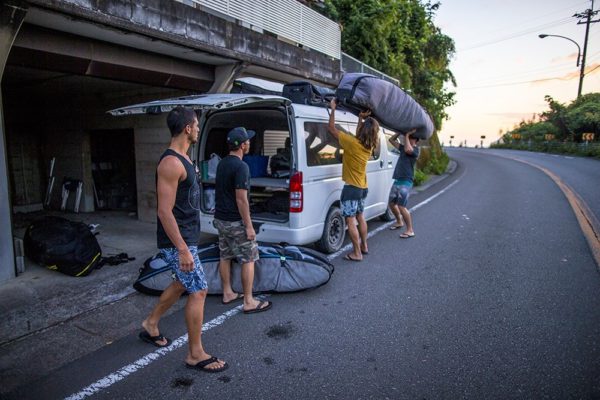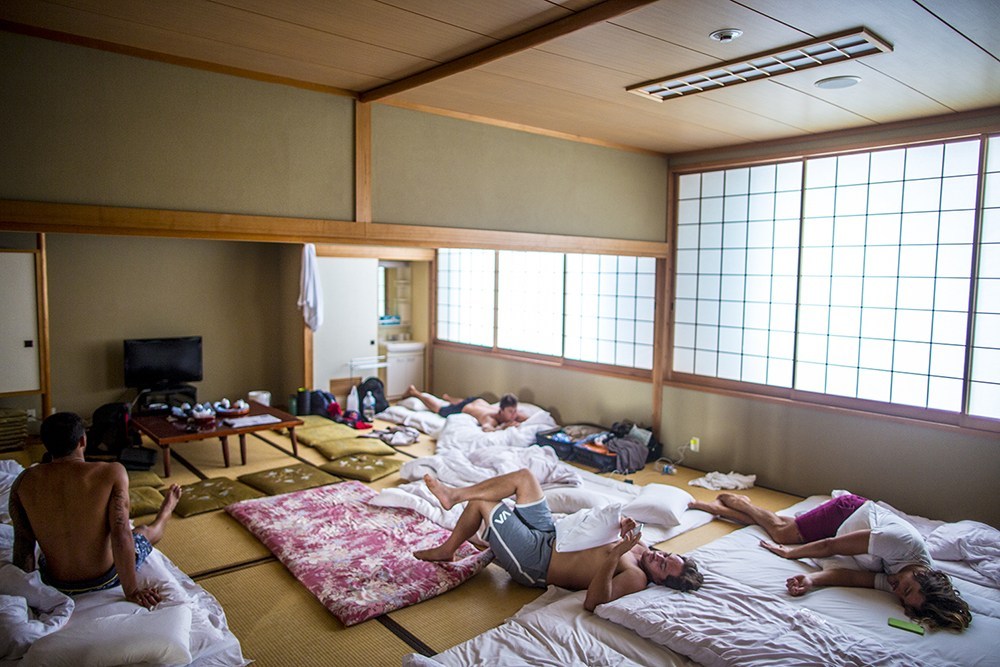In about 5 months’ time, surfing will make its Olympic debut at the 2020 Games in Japan–which means if you’ve purchased tickets to check out the event in person at Tsurigasaki Beach, you’d be wise to start planning your trip now. Or like yesterday.
It goes without saying that crowds, traffic and expenses are going to be through the roof during the 2020 Games. According to the NYTimes, an estimated 600,000 overseas visitors are expected to descend upon Tokyo and its surrounding regions during the event’s window–and that’s not even including the number of Japanese locals who will be traveling to the area. Point being, if you plan on attending the surfing event in Chiba, which will be held from July 26th to August 2nd, you’ll need to map out a carefully planned itinerary to make sure you’re in the right place at the right time.
For advice on how to execute the perfect visit to Japan during this sure-to-be-hectic event, we turned to pro surfer and Japanese national Masatoshi “Mar” Ohno, who grew up surfing just southwest of Tsurigasaki at Tatado Beach in Shimoda. From how to get in and out of Tokyo and Tsurigasaki in one piece to where to eat, drink and surf, Masatoshi shares his trips for surfers visiting the area. He even gives us the low-down on a few of his favorite surf spots to check out in the event that surf gets too good just to watch.
And what about the coronavirus threatening to put the kibosh on surfing’s Olympic debut, you ask? The IOC and Japanese officials are proceeding forward with plans for now and haven’t made any announcements about canceling the event. That being said, it also wouldn’t hurt to purchase some travel insurance.
“If you don’t rent a car, the train will be your only viable option getting from Tokyo to Tsurigasaki – just make sure you book your seats in advance,” says Ohno. “Whether you’re traveling from Haneda or Narita, public transport to Tsurigasaki will be a mission, though coming from Narita would definitely be easier since Narita is also in Chiba [Prefecture].”
“There is simply no straightforward, pain-free, tourist-friendly way to get from Haneda to Tsurigasaki by public transport, especially if you’re traveling with a surfboard. From Narita, you have to change trains at least once, at Chiba Station, but if you don’t have much luggage it should be ok.”
“If you take a taxi from the airport, never mind the crazy price; how are you going to get around the Tsurigasaki area without a car? It’s the same problem if you take the train—after arriving in Tsurigasaki, what next? There’s a taxi stand at the train station, but once you’ve arrived at your hotel you’ll have to get the hotel to order you a taxi, wait patiently for the taxi to arrive (which may take a while), etc.”
There are really no two ways about it: Lodging is going to be expensive in Tokyo and Tsurigasaki. Masatoshi suggests staying a little outside of Tokyo, and booking a hotel room in Tsurigasaki the night before the days for which you have tickets. In Tsurigasaki, TENT is an ultra-modern glamping resort that’s only about a 10-minute bike ride from the event, and COFF is similarly modern and spartan, with rooms regularly starting at around $45 a night, but it’s hard to say what surging we’ll see. Masatoshi’s advice? Wherever you plan to stay, book now.
Your best bet will be outlying districts. Check out Shimokitazawa for a more bohemian, laid-back old-Tokyo vibe, and Shibuya for something a little closer to the center of town. Airbnb may be your best bet in both places, but Shibuya has a number of hotels as well.
“Crowds, traffic, and prices are gonna be crazy in central Tokyo, so I’d pick the outskirts/outlying districts,” says Ohno. “For Tsurigasaki, look at what it says on the official website:
‘The competition schedule is subjected [sic] to change depending on the wave conditions. If conditions allow, the competition can be completed in four days, but it is possible that more time could be required. Because of this, the actual competition days for the Surfing events will be held over four days sometime between 26 July to 2 August.’
“There’s no way of predicting exactly which days the competition will be held, and your ticket will only be valid for a particular day, so bear in mind that if the competition is postponed to another day, tough luck, your options are to either spend the entire day at the Festival or head into Tokyo for more options.”
With this in mind Ohno suggests booking a room in Tsurigasaki for the night before, “so that next morning I’d have minimum stress getting to the venue, but for the rest of my trip before and after I’d stay in Tokyo. If you stay in Tokyo the night before you’re scheduled to watch the event, there’s no guarantee you’ll actually get to Tsurigasaki in time the next day, because there’s a good chance the train tickets will be sold out! Again, seats are limited, and every summer the train tickets are frequently sold out catering to the domestic crowd alone, so imagine what it’s gonna be like when there is a sudden influx of visitors from around the world—you’d be lucky to get a ticket allowing you to stand in the aisle beside the bathroom for the one-hour ride from Tokyo Station to Kazusa-Ichinomiya Station (the nearest station from Tsurigasaki).”
Just bear in mind there aren’t many dining, sightseeing, or shopping options in Tsurigasaki. “If you only have a ticket allowing entry to the event for one day, one night there is enough, unless your main agenda is to surf–in which case, you may want to save your trip for after the festivities wind down,” says Ohno.
“I like quaint little places with lots of character, but those restaurants aren’t equipped to handle foreigners—no English menus, no photos, etc., plus seating is extremely limited,” explains Ohno. “So I’d stick to those restaurants that at the very least have photos on their menus, even if they may not have English menus or English-speaking staff.”
In Tokyo
SUSHIRO: Conveyor-belt Sushi
TORIYOSHI: Famous for their chicken wings, yakitori and various other Japanese dishes
BANYA: A wide selection of traditional Japanese cuisine (Sashimi, Hotpots, Tempura, etc)
TOKYO RAMEN STREET: Sample different styles of Ramen renowned in various regions throughout Japan
SARASHINA HORII: There are many different types of Soba, this is one of the few places serving Ohno’s favorite — Sarashina Soba
MARUTOYO at Tsukiji Fish Market: For Onigiri and Musubi
In Tsurigasaki
“You can get Karaage (Japanese-style fried chicken) just about anywhere in Japan, from high-end eateries to supermarkets and convenience stores,” says Ohno. “They’re always very good, but I was blown away by the Karaage at this little takeout called Chicken and Chips. Everything on the menu is delicious, but my favorite is the simple ‘Fried Chicken Box’.
The region is famous for Hamaguri (large clams), which are usually steamed in rice wine or grilled over charcoal, but I also love the clams in pasta or ramen. ELIAS GARDEN [which also has accommodations] serves Hamaguri Monja, which is a Japanese-style ‘crepe’ filled with vegetables and Hamaguri clams, prepared on a hotplate like Teppanyaki. There’s also a morning fish market every Sunday from 8 am to 12 noon in the neighboring village of Oohara, Isumi, where you can pick live seafood and BBQ it on the spot, but their website doesn’t have an English page so I’m guessing they don’t really cater to tourists.”
As for what to drink, Ohno suggests taste-testing some sake (rice wine). “Try some of the sake brands the Chiba region is famous for, like Fusano Kankiku (Narita region) or Naruka (brewed in the famous surf town Katsuura close to Tsurigasaki),” says Ohno.
It’s no surprise the Japanese coastline can see pumping swell –whether or not it’ll show up during the event’s short window during the dead of summer remains to be seen. Still, Ohno recommends bringing your boardbag to Japan. “There’s plenty of points on either side of the contest beach: Sunrise, Hebara, Malibu, Kamogawa, to name but a few,” says Ohno. “If you want to go further, consider Shimoda and Okinawa. If you want to go surfing, your hotel can order a taxi to drop you off at the beach, but you’ll have to figure out how to get back. I guess you could rent a bicycle, but it could rain (plenty of typhoons during the summer) and if you want to explore surf points up and down the coast, there’s a limit to how far you can go on a bicycle. My point is, if you want to have access to more surfing (and dining) options, rent a car.”
Cover your tattoos: According to Ohno, there are some rather strict cultural rules when it comes to showing tattoos in certain situations. “If you have any tattoos, then you’re basically not allowed entry at any swimming pools, hot springs, spa facilities, public baths, etc,” says Ohno. “If your tattoo is tiny and in an inconspicuous part of your body, maybe no one will notice. If not, some places actually provide stick-on patches for covering tattoos.”
Don’t be annoying with your cell phone: “Cell phones should be in silent mode in all public places (restaurants, hotel lobbies, trains, shops etc),” explains Ohno. “On trains and buses, talking on cellphones is not ok, so if you absolutely have to answer your phone, speak very softly.
Don’t bargain with vendors: “If you want to buy something but you’re not ok with the price, just put it back, don’t try to bargain,” says Ohno. “It’s just not done in Japan.”
Be courteous when visiting public baths/pools: According to Ohno, public paths are meant to be places of serenity and quiet relaxation, but there are rules you must follow when visiting them. “Before getting into the pool or tub, soap, shampoo and rinse yourself thoroughly at the showers first; don’t get into the pool/tub until you’ve rinsed off all the soap and shampoo completely,” he says. “Don’t let your hair dip into the water; bring a clip to keep your hair up. fabric of any kind is not allowed in the water, so don’t wear any swimwear or undergarments. Only wear swimwear if you’re visiting one of those mixed gender hot springs where you see that all the locals are also in their bathing suits. Also, don’t dip your face into the water, try not to horse around, talk loudly, etc.”
Respect the ways of taxi drivers: “Taxi drivers in Japan get really upset whenever tourists close their car doors, ‘cause the rear doors of taxis are automatic, and if you keep forcing them to shut manually it damages the mechanism,’ says Ohno. “So wait patiently for the doors to open automatically before getting in or out of the taxi. Usually all the doors are automatic, but on older taxis sometimes only the rear doors are auto, or all doors are manual. It’s tricky.”







Recent Comments